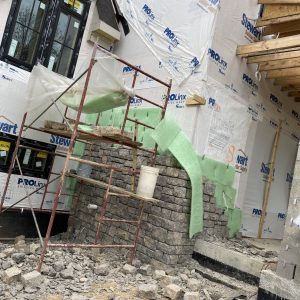Reverse Vapor Drive??? – Interesting issue
We just completed a build in Middle TN at end of 2020 (south of Nashville) and are experiencing “damp” conditions in an exterior wall cavity. (discovered when I mounted some floating shelves). Not wet, no sign of leaks but “damp” as if very high humidity air is trapped and somewhat condensing on other side of conditioned space. Area identified happens to be very large section of full TN limestone exterior that faces S/SW and obviously heats up in summer/early fall. Clearly also absorbs moisture… and maybe pushes humid air in…?. It’s only about 12′ section and extends from foundation to roofline so both 1st and 2nd floors are impacted.
Current wall make up, from outside to inside is: 4 to 6″ full TN Limestone / 1″ Cavclear (moisture/air maintenance) / house wrap / 1/2 OSB sheathing / bat insulation / Drywall
Hoping to get some ideas for remediation… thoughts are:
1. Tear out drywall and spray-foam against OSB; concern here is I rot out my OSB as just moves problem 1 layer out?
2. Tear out drywall and install attic baffles behind the insulation and then vent it at top and bottom of interior walls. Not pretty aesthetically and creates more issues for HVAC but gets moist air out of wall cavity?
3. Others???
thanks in advance for thoughts. Pics for clarity.























Replies
What about sealing the limestone? It would be something that becomes a maintenance task, but it may address the root cause instead of investing in a mitigation.
Good luck.
Hmm, not a bad thought. Appreciate the feedback
Good idea, sealing the limestone is interesting.
Did you install weep vents (or enough weep vents)? May need to add a bit more ventilation directly behind the stone itself. The Cavclear helps maintain the proper airspace, but if no air (or not enough air) is entering the cavity it kind of defeats the whole purpose of the airspace. Thicker stone/brick veneer retains more moisture, so venting needs to be kicked up a notch. Also, brick vents will perform better than weeps for maximum airflow.
J, good to see you back.
Thanks for that and there r zero weep vents to my knowledge, only cloth strings they said would release moisture. I will ck with masons… would u install high amd low?
The more the better. If it were mine, I would install weep vents 2’ O.C. on the lower course(s) of stone, but keep them high enough to prevent water intrusion in the event you experience a bit of flooding. If you have a vented attic drill 3”(ish) size holes within the wall sheathing in attic, so air can be carried out through to the roof vents. If no vented attic, use weeping vents (or brick vents) spaced 2’ O.C. along top of gable, or incorporate venting within your gable trim (soffit details). Example, intentionally leave gable trim 1/4” away from the stone and do not seal it in to allow air passage. You could simply chip/drill away mortar without inserting weeps or vents at strategic locations as well if the Cavclear mesh is tight enough to prevent vermin and insect intrusion. If Cavclear mesh is quite loose and allows insects to crawl through you will want to use weeps or vents with insect screening abilities. I used cavity mats once, I was not a fan, so can’t remember how tight the matting is.
thanks very much jlyda - very helpful! Venting stone is certainly doable. Also like your thoughts about getting to vented attic (which it is). Wonder if it's worth taking interior drywall off and drilling holes from 1st floor up through wall plate in each stud bay for ventilation and doing the same from 2nd floor into attic space? Insert insulation baffles next to OSB and then re-install bat insulation. Big PIA but may also help.
I would not do that. Your building envelope starts at house wrap, if you cut into that you are bringing moisture in that you want to keep out. Also, drilling holes in top plates is against building/fire code, it creates a path of air between floors.
thank you again jlyda.. upon further review the attic is really not accessible as the 2nd floor room has vaulted ceiling and follows roof line. I think your thought of venting, venting and more venting is probably the best course of action. I am wondering if I will have issues on other portions of the home that have stone cladding but not quite this much continuous... may have them vent everything with stone just to be safe
This is a classic problem that Lstiburek describes in his talks, but usually with brick. The masonry gets wet, and then the sun hits it. Moisture drive is from warm to cold, wet to dry. The warm southwestern sun pushes the moisture through the masonry toward the cooler (air conditioned?) space. I'd try a masonry sealer first. Otherwise, I think you're tearing the wall apart.